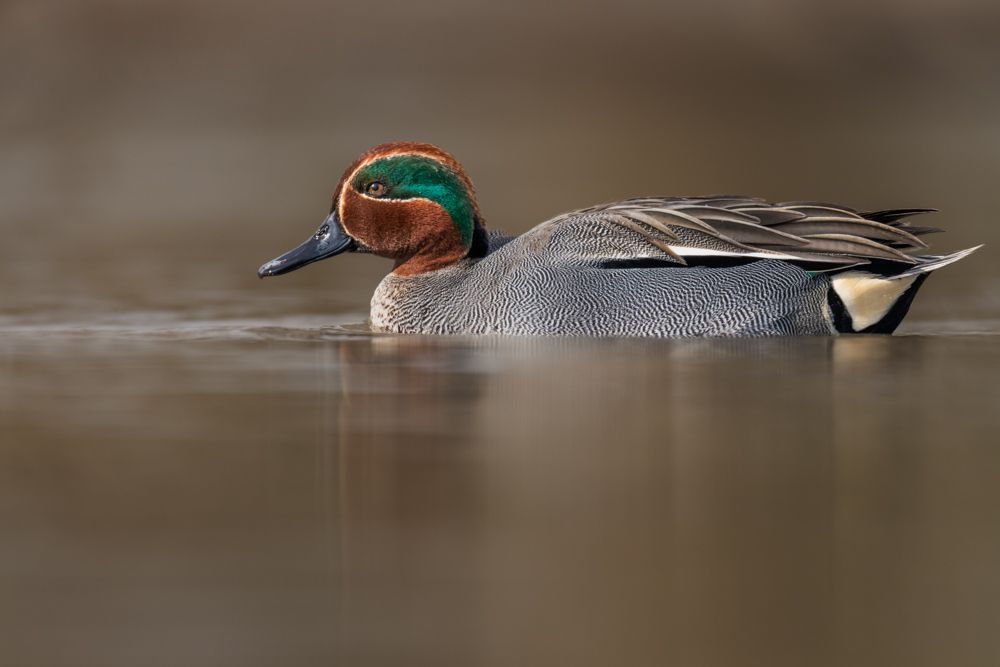Scientific name: Anas crecca
Class: Birds
Order: Anseriformes
Family: Anatidae
Length: 34-38cm
Wingspan: 58-64cm
Weight: 250-400g
Distribution: Northern hemisphere
breeding stock CH: 0-2 pairs
Habitat: Lakes, slow-flowing waters
Migration behaviour: Short-distance migrant
The teal is the smallest duck in Europe and stands out among other ducks. Only the garganey is almost as small as the teal. In addition to its small size, the teal shows many unique characteristics, which makes it easier to identify the duck.
The male in the breeding plumage has a unique head pattern. The feathers of the half-moon shape are almost black but shimmer greenish in the light. The dark feathers of the half-moon and the brown feathers on the head are separated by a thin white line. The beak is dark grey to black. The body is mostly finely patterned and appears at greater distances as a uniform grey. Above the sides the male has a white and a black horizontal band. The tail is white to cream coloured.
The male common teal can hardly be mistaken for the male because of its size and the unique head pattern. Only the green-winged teal has strong similarities with the common teal. However, this duck originates from North America and very rarely comes to Europe. Because the two species are so similar, they are often described as one species.
Identifying the female dabbling ducks can be difficult. Because of the rather small size of the teal, it is one of the easier species.
The teal mainly breeds on smaller lakes with dense shore vegetation. In winter, the teal is also found on other waters. It prefers shallow waters all year round.
In Switzerland, the common teal is almost only here during winter. However, the winter population fluctuates greatly from year to year. The weather conditions influence how far south the individuals have to move in order to find open waters. In the winter of 2017, for example, there were approximately 12’000 teals. The following year, however, only 4’000 individuals could be counted. Locally, populations are also influenced by water levels.
As a breeding bird, the teal is only recorded irregularly. If at all, a maximum of 2 females were breeding per season in recent years. However, because the teal is very secretive, it is possible that other breeding birds have gone unnoticed.
The teal feeds on seeds and small invertebrates. I actually have already observed how teals have eaten the bread of passers-by. But I saw this only once and it is rather harmful for ducks in general. Although bread provides easy energy, the high amount of salt is extremely unhealthy for the ducks.
Typical for ducks, the female duck is on its own during nesting season. The nest is well hidden in the dense shore vegetation. In spring the female lays between 6 and 12 eggs in the nest. After 21 to 23 days the young hatch and leave the nest shortly after. The young are also called nest escapees. For the next 40 to 50 days they are guided and protected by their mother. However, the young have to find and take in the food themselves.
The teal belongs to the short-distance migrants. In autumn, the ducks leave their breeding areas in the north and move to the southwest in order to find open waters.
Because teals are still hunted, they are relatively shy. They are also rather small, which makes it even more difficult to photograph them. In Switzerland, you can observe and photograph the common teal in winter, for example at Lake Constance or at the Klingnau Stausee. The Klingnauer Stausee is especially suitable for this because you have the possibility to get down to eye level with the ducks.
Depending on the light the iridescent feathers on the head are very dark. This is happening especially when it is very cloudy. To photograph teals, I prefer direct sunlight. With direct sun light the feathers always shimmer very strongly and make for a better image.
The population figures, length, weight and wingspan correspond to the data of the Vogelwarte Sempach
Information on behaviour, distribution etc. is based on my own observations and was supplemented with information from the following sources:
The Birds of Switzerland (2007) Lionel Maumary et al.
Swiss Breeding Bird Atlas 2013-2016
The Cosmos Bird Guide (2017) Lars Svensson et al.
Nicolas Stettler
Weyernweg 27
2560 Nidau
4.10.2023
© 2022 Nicolas Stettler. ALL RIGHTS RESERVED
